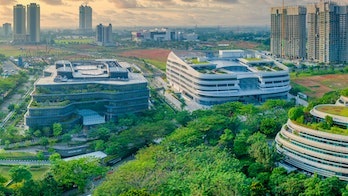Brazil
Brazil’s energy policies measure up well against the world’s most urgent energy challenges. Access to electricity across the country is almost universal and renewables meet almost 45% of primary energy demand, making Brazil’s energy sector one of the least carbon-intensive in the world.
Read more
Total primary energy demand has doubled in Brazil since 1990, led by strong growth in electricity consumption and in demand for transport fuels on the back of robust economic growth and a burgeoning middle class.
Large hydropower plants account for around 80% of domestic electricity generation, making the Brazilian electricity mix one of the cleanest in the world. Continued expansion of hydropower is increasingly constrained by the remoteness and environmental sensitivity of a large part of the remaining resource. PV projects (utility scale and distributed) will represent nearly 70% of all additions in the coming years. Reliance on other sources for power generation is also growing, notably natural gas, wind (on-shore and off-shore) and bioenergy. Brazil is a global leader in second generation biofuels and flex-fuel cars provide a large domestic market. Ethanol supply is set to average 660 kb/d in 2026, up 90 kb/d compared with 2020 and 35 kb/d higher than in 2019. A system of contract auctions provides a mechanism to bring forward investment in new generation and transmission capacity, as well as to diversify the power mix.
Large offshore oil and gas discoveries have confirmed Brazil’s status as one of the world’s foremost oil and gas provinces. Pre-salt discoveries also prompted a change in upstream regulation, granting Petrobras – the national oil company – a strengthened role in areas deemed strategic. Production from the deep-water pre-salt fields in the Santos basin has gained considerable momentum in recent years, offsetting declining output from mature fields elsewhere. Thanks to such successful developments in deep-water production, Brazil turned into a net oil exporter in 2017. As a result, total oil supply is expected to grow by 1.2 mb/d to 4.2 mb/d in 2026, according to IEA forecasts.
At COP26 where Brazil announced a long-term objective to reach net-zero emissions by 2050 and a 50% carbon emissions reduction plan coupled with a zero illegal deforestation target by 2030. This is supported by an announced 2030 climate action plan and a hydrogen national strategy which is being developed.
Large hydropower plants account for around 80% of domestic electricity generation, making the Brazilian electricity mix one of the cleanest in the world. Continued expansion of hydropower is increasingly constrained by the remoteness and environmental sensitivity of a large part of the remaining resource. PV projects (utility scale and distributed) will represent nearly 70% of all additions in the coming years. Reliance on other sources for power generation is also growing, notably natural gas, wind (on-shore and off-shore) and bioenergy. Brazil is a global leader in second generation biofuels and flex-fuel cars provide a large domestic market. Ethanol supply is set to average 660 kb/d in 2026, up 90 kb/d compared with 2020 and 35 kb/d higher than in 2019. A system of contract auctions provides a mechanism to bring forward investment in new generation and transmission capacity, as well as to diversify the power mix.
Large offshore oil and gas discoveries have confirmed Brazil’s status as one of the world’s foremost oil and gas provinces. Pre-salt discoveries also prompted a change in upstream regulation, granting Petrobras – the national oil company – a strengthened role in areas deemed strategic. Production from the deep-water pre-salt fields in the Santos basin has gained considerable momentum in recent years, offsetting declining output from mature fields elsewhere. Thanks to such successful developments in deep-water production, Brazil turned into a net oil exporter in 2017. As a result, total oil supply is expected to grow by 1.2 mb/d to 4.2 mb/d in 2026, according to IEA forecasts.
At COP26 where Brazil announced a long-term objective to reach net-zero emissions by 2050 and a 50% carbon emissions reduction plan coupled with a zero illegal deforestation target by 2030. This is supported by an announced 2030 climate action plan and a hydrogen national strategy which is being developed.
Last updated May 23, 2023

Key energy statistics
Brazil data explorer
Analysis
-
Cost of Capital Observatory
Tracking the cost of capital for clean energy projects in emerging and developing economies

-
Brazil Energy Profile
-

Latin America Energy Outlook 2023
-
Implementing Clean Energy Transitions
Focus on road transport in emerging economies

-
Biofuel Policy in Brazil, India and the United States
Insights for the Global Biofuel Alliance

-
Brazil aims to make a global impact on clean energy innovation
-
Clean Energy Transitions Programme 2022
Annual report 2022

-
Boosting Efficiency in Latin America
Delivering affordability, security and jobs to advance people-centred energy transitions

Events
28 Oct 2021
13 Aug 2021
Launch of Brazil’s Inova-e Platform to strengthen tracking of clean energy innovation
05 May 2021 15:00—16:15
Launch of Online Course on Energy Efficiency in Buildings for Brazil
15 Apr 2021 21:00—22:10
Atlas of Energy Efficiency Brazil, 2020, Main Findings
Latest news
Executive Director discusses G20 energy and climate priorities with Brazilian and Indian Ministers
IEA deepens cooperation with Brazil with new benchmarking report on the pulp and paper sector
IEA contributes to Brazilian government report on energy efficiency of road freight sector
Multilateral Meeting strengthens IEA’s global leadership role
Policies
Policy
Country
Year
Status
Jurisdiction
-
Brazil 2023 In force National
-
Brazil 2023 In force National
-
Brazil 2022 In force National
-
Brazil 2022 In force National
-
Brazil 2022 In force National
-
Brazil 2022 In force National
-
Brazil 2022 In force National